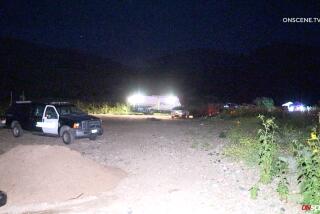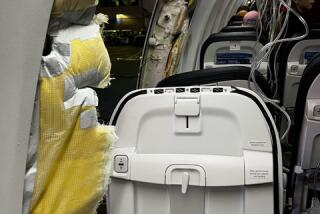Golfer’s Jet Flies to Its Doom in Eerie Voyage
A Learjet carrying U.S. Open golf champion Payne Stewart and at least four others flew uncontrolled for nearly five hours above the nation’s heartland Monday--its windows iced over, its radio silent and its passengers and crew apparently unconscious or dead--before running out of fuel and plummeting 45,000 feet into a muddy field of weeds near Mina, S.D. All those aboard were killed.
The cause of the accident could take months to determine, but aviation experts speculated that the twin-engine Lear 35 may have experienced a catastrophic loss of cabin pressure soon after taking off from Orlando, Fla., en route to Dallas.
Air-traffic controllers lost radio contact with the plane after they cleared it to climb past 39,000 feet. At that altitude, a decompression would plunge the temperature inside the plane well below zero, and those aboard could begin to experience hypoxia and loss of consciousness within 10 seconds unless they were able to put on emergency oxygen masks.
Air Force fighter pilots flew alongside the jet for much of its eerie, 1,400-mile journey and reported no signs of life inside the cabin. The plane was apparently on autopilot.
Military officials monitored the path of the plane closely but said they never considered shooting it down because it was not a threat to a heavily populated area.
Shortly after 1 p.m. CDT, two F-16C pilots from the Oklahoma Air National Guard “watched it begin to go out of control,” Major Willie Braggs III said.
“They saw it do an aileron roll--go wing over wing--and then go into a spin. They lost visual as it went below 10,000 feet, and then picked it up again when it crashed.”
The plane all but disintegrated when it slammed into a waterlogged field outside the tiny town of Mina. No one on the ground was injured.
In addition to the flamboyant 42-year-old Stewart--easily recognizable on the links in his trademark knickers and tam-o’-shanter hat--the dead included his agents, Robert Fraley and Van Ardan, and pilots Michael Kling, 43, and Stephanie Bellegarrigue, 27.
Number of Passengers Unclear
Although the plane’s flight plan listed a crew of two and three passengers, sources in the golf community said a sixth person may have been aboard, a golf course designer.
The ghostly high-altitude tragedy began to unfold shortly after 9:20 a.m. EDT, when Stewart and his agents took off for Texas, first for a meeting on a proposed golf course near Dallas and then on to the Tour Championship in Houston.
They decided to travel in the 23-year-old Lear 35, which Stewart partly owned. Kling--a former Air Force pilot and high-altitude flight instructor, according to the plane’s operator, Orlando-based Sunjet Aviation Inc.--was at the controls. Bellegarrigue was in the co-pilot’s seat.
As the plane climbed across the skies above Gainesville, Fla., 100 miles northwest of Orlando, air-traffic controllers noticed “significant changes in altitude,” radioed and got no response, Federal Aviation Administration spokesman Paul Turk said.
After numerous unsuccessful efforts to contact the plane, the FAA called the Air Force, which diverted an F-15 on a routine training mission out of Tyndall Air Force Base in Panama City, Fla. It would be the first of at least five fighter jets that would monitor Stewart’s plane and try to make contact.
The F-15 pilot reported seeing ice on the Learjet’s windows, and he was unable to make visual contact with its occupants. As the troubled plane continued northwest, two fighters from Eglin Air Force Base, Fla., took over. Again, no response, no indication that anyone inside was alive or that anything but the autopilot was controlling the plane.
Air Force Capt. Chris Hamilton caught up with the Learjet over Memphis, just before noon. “It’s a very helpless feeling to pull up alongside another aircraft and realize the people inside that aircraft potentially are unconscious or in some other way incapacitated,” Hamilton said. “And there’s nothing I can do physically from my aircraft, even though I’m 50 to 100 feet away, to help them at all.”
By the time Hamilton was intercepting the Learjet, the wayward aircraft had the attention of the Pentagon and the White House.
Officials wanted to know where the plane was headed--and when and where it would run out of fuel and fall to earth.
At 12:16, with the Learjet over southern Kansas, military analysts estimated that the plane had about an hour’s worth of fuel remaining. It would crash, they predicted, somewhere in the sparsely populated Dakotas. About 1 p.m. two armed Air Force F-16s in Fargo, N.D., were placed on alert. They were never ordered to take off.
Shooting the plane down “was never an issue,” said Pentagon spokesman Kenneth Bacon.
About the time the analysts were predicting a crash in the Dakotas, Air Force Lt. Col. Mike Hepner and Major Mike Husted of the Oklahoma Air National Guard were peeling away from their group of eight F-16s to pick up the chase. They had been practicing air-to-air intercepts. Now they were being asked to perform one.
They climbed to meet the high-flying jet.
“It was flying straight and level at 45,000 feet,” said Braggs, a base spokesman. “But the windshield was iced. They couldn’t see the pilots. They made at least a couple of passes that came within a couple hundred feet, but they couldn’t see in. They said they could not tell if there was any damage to the aircraft.”
Altitude Varied From 22,000 to 51,000 Feet
The pilots refueled three times in the air and continued to follow the Learjet. It dived as low as 22,000 feet and climbed as high as 51,000 feet, but it never wavered from its northwest heading.
Then, shortly after 1 p.m., the fighter pilots radioed in. The plane was beginning to roll, then spin. It disappeared from the pilots’ view at 10,000 feet, and reappeared a few moments later to a handful of residents of Mina below.
It hit nose first, witnesses said, and all but disappeared. Consistent with the belief that it ran out of fuel, there was no explosion. While investigators from the National Transportation Safety Board declined to speculate on the cause of the unusual accident, aviation experts said all the signs pointed to a rapid depressurization, which could have been caused by a structural failure--such as a broken window or leaking door seal--or by a malfunction of the plane’s outflow valve.
The outflow valve is designed to slowly bleed off excess air pumped in by the engines to maintain the desired air pressure inside the plane, said Barry Schiff, a retired TWA pilot and air safety consultant. Although a structural failure may or may not be visible to a chase plane, a failure of the valve could certainly not be seen from the outside.
In the event of a depressurization at 40,000 feet or more, the pilots and passengers could have lost consciousness in a matter of 10 seconds. But pilots are trained to react in such situations, said Lou Aaronson, a retired Learjet and Continental Airlines pilot.
“You know your emergency procedure from memory: Get that mask on, establish communications, start descending,” Aaronson said. “There are plenty of warnings [including sirens and flashing lights], and they’re not subtle.”
Schiff said that could indicate a second failure of some kind--of the warning systems, or of the emergency oxygen masks to function properly.
But the odds against two systems, the pressure and warning systems, failing at the same time are very high, Schiff said, adding that the investigation may well focus on the pilots’ reactions or perhaps on the maintenance of the emergency oxygen systems.
(BEGIN TEXT OF INFOBOX / INFOGRAPHIC)
Ghostly Journey
1. Plane leaves Orlando at 9:20 a.m. EDT
2. F-15s begin monitoring flight
3. F-16s take over shadowing the plane
4. Hours later, Learjet crashes
*
Survival Time
Estimated time of useful consciousness after a pressure-system failure:
*
*--*
Altitude Time 20,000 ft. 10 min. 30,000 ft. 30 sec. 40,000 ft. 15 sec.
*--*
*
Learjet 35
Cruising Speed: 500 mph
Max. Range: 2,300 miles
Cruising Altitude: 41,000 ft.
Capacity: 8 passengers, 2 pilots
*
Sources: Private Pilot Manual, Jane’s All the World’s Aircraft, Reuters, Associated Press
*
Times staff writer Thomas Bonk and researcher John Beckham contributed to this story.
* MEMORABLE GOLFER
*
Payne Stewart, ’99 U.S. Open winner, stood out for more than his trademark clothes. D1
More to Read
Start your day right
Sign up for Essential California for news, features and recommendations from the L.A. Times and beyond in your inbox six days a week.
You may occasionally receive promotional content from the Los Angeles Times.





